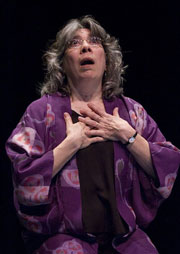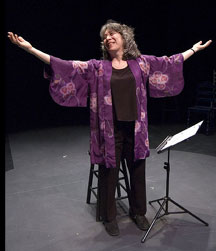|
Sound. To better understand and appreciate the work of Gertrude Stein, one must hear aloud the poetic texts of this most under-read Modernist writer.
ODD ENTRANCE INTO THE WORLD
On April 1, 2008, the Steiny Road Poet ventured out to Columbia, Maryland, where Rep Stage, a professional theater in residence at Howard Community College, was featuring Thom Pain (based on nothing) by Will Eno and offering as a companion piece in their “Off-Nite Series,” Ida, a forty-five-minute performance work based on an excerpt from Gertrude Stein’s 1940 novel by the same name. Wendy Salkind who is the narrator of Ida teamed up with composer Linda Dusman to create this sound-oriented performance.  The Steiny Road Poet bases this sound-oriented label on these facts: 1) a sole performer (Wendy Salkind) reads from a music stand (barebones props) and 2) what the performer reads is coordinated with a sound track that includes electronic reverberation, an occasional recorded song (e.g. “I Want to Be Loved by You”—picture Marilyn Monroe singing this.), and the recorded voice of Salkind playing against her own live voice. The Steiny Road Poet bases this sound-oriented label on these facts: 1) a sole performer (Wendy Salkind) reads from a music stand (barebones props) and 2) what the performer reads is coordinated with a sound track that includes electronic reverberation, an occasional recorded song (e.g. “I Want to Be Loved by You”—picture Marilyn Monroe singing this.), and the recorded voice of Salkind playing against her own live voice.
In the coming-of-age excerpt, Ida is depicted from birth to young woman of the marrying age. She has had an odd entrance into the world. Her mother tried literally to hold her back from leaving the womb. However, Stein said matter-of-factly, “When the time came Ida came.” Moreover, Stein reports Ida came with her twin Ida-Ida. However, Ida-Ida, a suicide blonde who wins a beauty contest, seems to be the wishful thinking of a lonely girl whose parents left on a trip without their baby and never came back. In Ida, Stein addresses identity. She specifically wrote this novel to deal with the question of what happens when a person has had so much publicity that she (Stein had this experience during her 1934-35 lecture tour) loses her identity.
SPACED OUT TEXTS AND SURROUND SOUND
In a telephone interview conducted April 7, Dusman said that Salkind, who 20 years ago had directed a student production of Stein’s play Listen to Me, approached the composer in the year 2000 to talk about doing a collaborative Stein piece. At that time, Dusman had been selected for a teaching position at the University of Maryland Baltimore Campus and Salkind had been on the search committee that found her. Dusman, known as a “sound artist,” started experimenting with “spatialized texts” in the 1980s, including her work on an excerpt from Gertrude Stein’s The Making of Americans. By 2000, this Stein excerpt entitled Becoming Becoming Gertrude was released by Capstone Records.
Dusman said spatialized texts are “texts that are spread around a space in some way. Composers have used technology to distribute the sounds of the spoken (or spoken or sung texts processed via computer technologies) around a space via loudspeakers. Ida has some of this happening--depth of sound is created through the use of reverberation, and the sound [occasionally] moves from one stereo speaker to another--and then sometimes in unison with Wendy.”
STEIN’S TIME WARP
Part of Stein’s writing philosophy deals with creating the present moment, therefore making time a cornerstone in how she developed her work. In the performance piece Ida, Dusman and Salkind extend the experience of receiving Stein’s poetry. Sometimes this played out in a time warp as Salkind’s recorded voice preceded or followed Salkind’s live presentation.  The unity of Salkind’s voice live and recorded is carefully engineered by Julianne Franz who serves as the sound operator and stage manager. In the talk back session after Salkind’s performance, Franz described her process and it seemed to the Steiny Road Poet to be a blend of intense intuition and timing, but also a cultivated harmonic convergence. The unity of Salkind’s voice live and recorded is carefully engineered by Julianne Franz who serves as the sound operator and stage manager. In the talk back session after Salkind’s performance, Franz described her process and it seemed to the Steiny Road Poet to be a blend of intense intuition and timing, but also a cultivated harmonic convergence.
A favorite interpretation of Stein’s Ida text was Salkind’s rhythmic reading of the man from Omaha passage that begins “Once in a while a man is a man and he comes from Omaha, where they catch all they can. He almost caught Ida. It happened like this.” Enhanced by snare drums as the Steiny Road Poet recalls, this section of the performance could have easily been accompanied by an improv tap routine by the likes of 1930s jazz hoofers Chuck Green, Sandman Sims, and Bunny Briggs (find them in George Nierenberg’s documentary film No Maps on my Taps.)
Other thoughts that popped into the Dresser’s head about this text are that Stein often recycled characters, names, and ideas from one work to another. For example, Ida had a blind dog named Love and a dog named Love also appears in her children’s story The World Is Round (completed in 1938). Stein has a character in her opera libretto Doctor Faustus Lights the Lights (completed in 1938) named Marguerite Ida and this character may be the same person as Helena Annabel. Names, in fact, preoccupy Stein in this work. “Ida was getting to be older. Sometimes she thought about a husband but she that a husband meant marriage and marriage meant changes and changes meant names and after all she had so many changes but she did have just that one name Ida and she liked it to stay with her.” Name changes also preoccupy characters in The Mother of Us All (completed in 1946), Stein’s second and last opera with Virgil Thomson. In Mother, she makes fun of women who change their names, but also points out that if men were in the same situation, they would be bereft over losing their identity.
What the Steiny Road Poet always finds interesting about Stein is how wide her writerly universe is. In Ida, there is a tiny story about how Ida’s great aunt had buried her twin babies under a pear tree (yes, Stein likes puns, twinning pear and pair) but she also weaves in an ongoing thread about possibly politically incorrect commentary on encounters with people of color—Arabs and Negroes. Stein keeps her readers aware of other ponderous topics like war and religion versus bird watching and buying shoes. Salkind and Dusman have created satisfying access to Stein—her writing, her universe, her reality. The Poet recommends Salkind and Dusman’s Ida for as many productions as Salkind and Franz have the interest in rendering.
Photos - Rep Stage
|
